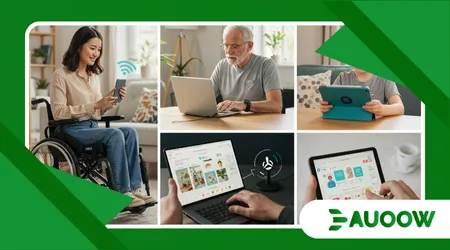Inclusive Design: Tech Products That Get It Right

Inclusive design isn’t just a buzzword it’s a revolution in how technology serves humanity.
In 2025, creating products that embrace accessibility ensures everyone, regardless of ability, can engage fully with the digital world.
This approach prioritizes universal usability, weaving empathy into innovation. From smart glasses to AI-driven assistants, tech is redefining inclusion.
This article explores standout products, their impact, and why inclusive design matters now more than ever. Why should tech exclude anyone when it can empower everyone?
The digital landscape has evolved rapidly, with accessibility becoming a cornerstone of innovation. Inclusive design transcends compliance, fostering products that resonate with diverse users.
It’s about anticipating needs visual, auditory, motor, or cognitive and crafting solutions that feel intuitive.
The World Health Organization estimates 2 billion people will rely on assistive technology by 2030, underscoring the urgency of this mission.
From startups to tech giants, companies are stepping up, and we’ll dive into those leading the charge.
The Philosophy Behind Inclusive Design
At its core, inclusive design is about empathy-driven innovation. It challenges developers to consider diverse user needs from the outset.
Think of it like building a house with ramps and wide doorways not as an afterthought, but as the foundation.
This philosophy ensures products are usable by people with disabilities, older adults, or anyone facing temporary limitations. It’s not charity; it’s smart design that benefits all.
++ The Best Free Assistive Technology Tools for Students with Dyslexia
Take Apple’s Assistive Access, launched in 2023. It simplifies iPhone interfaces for users with cognitive disabilities, using high-contrast visuals and customizable layouts.
This isn’t just for a niche it enhances usability for anyone overwhelmed by complex menus. By prioritizing clarity, Apple shows how inclusive design elevates the user experience universally.
Moreover, inclusive design aligns with ethical business practices. Companies that ignore accessibility risk alienating millions while facing legal repercussions, like fines under the European Accessibility Act 2025.
Designing inclusively builds trust and broadens markets. Isn’t it time we stopped treating accessibility as optional?

Wearable Tech: Seeing and Hearing the World Anew
Wearable technology is transforming lives through inclusive design. Lumen’s vision-impairment glasses, unveiled at CES 2024, mimic guide dog functionality.
Using self-driving car tech, they help visually impaired users navigate with confidence. These glasses aren’t just tools; they’re lifelines to independence.
Another game-changer is Starkey’s Genesis AI hearing aids. Equipped with neural networks, they filter noise and enhance speech clarity.
Also read: Robotics in Assistive Care: Innovations to Watch
Worn discreetly, they empower users in noisy environments, from bustling cafes to quiet offices. This is inclusive design at its finest seamless and empowering.
OrCam’s MyEye device takes accessibility further. Its AI reads text, recognizes faces, and describes surroundings via voice or gestures.
For visually impaired users, it’s like having a personal assistant, proving tech can bridge gaps with creativity. Wearables like these redefine what’s possible.
AI and Voice Assistants: Conversational Inclusion
Artificial intelligence is reshaping accessibility through voice-driven solutions.
Amazon’s Alexa and Google Assistant have evolved, with natural language processing improving for users with speech impairments.
These tools now understand nuanced commands, making tech accessible to those with motor or cognitive challenges.
Consider Microsoft’s Seeing AI, a free app for visually impaired users. It narrates surroundings, reads text, and identifies objects in real time.
Read more: The Role of Augmented Reality in Disability Inclusion
By leveraging AI, it offers independence to millions, showing how inclusive design can scale globally. It’s a digital bridge to the world.
Polly by Parrots Inc., launched at CES 2024, uses AI for real-time telehealth. It supports users with neurological impairments via voice and video, offering contextual help.
This isn’t just tech it’s a lifeline, proving AI can foster human connection through inclusive design.
Gaming and Accessibility: Play for All
Gaming is often overlooked in accessibility discussions, yet it’s a frontier for inclusive design.
Sony’s Project Leonardo for PlayStation 5, introduced in 2023, is a customizable controller for gamers with motor disabilities. Its modular design adapts to unique needs, ensuring everyone can play.
DreamFace Technologies’ Ryan, an AI-powered robot, enhances gaming for older adults. Beyond games, it offers yoga and cognitive exercises, fostering emotional well-being.
This blend of play and care shows how gaming can unite generations through inclusive tech.
Microsoft’s Xbox Adaptive Controller, updated in 2024, further democratizes gaming. With customizable inputs and compatibility with assistive devices, it ensures no one is left out.
Gaming’s universal appeal thrives when inclusive design removes barriers, inviting everyone to the virtual world.
The Business Case for Inclusive Design
Accessibility isn’t just ethical it’s profitable. A 2023 study by Accessibilitychecker.org found 73% of websites saw increased organic traffic after accessibility improvements.
Inclusive design boosts SEO by enhancing crawlability with clear headings and alt text, aligning with Google’s algorithms.
Consider the cost of exclusion: UK retailers lose £17 billion annually by ignoring accessibility. Inclusive websites attract diverse users, reduce bounce rates, and build brand loyalty.
Companies like Apple and Microsoft prove that accessibility drives innovation and market reach.
Legal compliance is another driver. The European Accessibility Act 2025 mandates accessible digital products, with fines for non-compliance.
By embracing inclusive design, businesses avoid penalties while gaining a competitive edge. It’s a win-win for ethics and economics.
Emerging Trends Shaping Inclusive Design

The future of inclusive design is bright, with emerging tech pushing boundaries. Gesture-based controls, like those in VR and AR, are evolving to support users with motor impairments.
These systems allow navigation without traditional inputs, opening new possibilities.
AI-driven accessibility testing is another trend. Tools like UserWay’s Accessibility Widget automatically identify and fix barriers, making compliance easier for businesses.
This tech ensures websites remain accessible as they scale, saving time and resources.
Haptic feedback is also gaining traction. Devices like HAPTA’s lipstick applicator, launched in 2023, use smart motion controls to assist users with limited motor skills.
These innovations show how inclusive design can blend precision with practicality, enhancing daily life.
Table: Key Features of Inclusive Tech Products
| Product | Accessibility Feature | Target Audience | Impact |
|---|---|---|---|
| Lumen Glasses | Self-driving tech for navigation | Visually impaired | Enhances mobility and independence |
| Starkey Genesis AI | Neural network for speech clarity | Hearing impaired | Improves communication in noise |
| OrCam MyEye | AI-driven text reading, face recognition | Visually impaired | Enables real-time interaction |
| Xbox Adaptive Controller | Customizable inputs for motor disabilities | Gamers with disabilities | Democratizes gaming access |
Real-World Impact: Stories of Inclusion
Imagine a visually impaired student using Seeing AI to read textbooks instantly. This isn’t a hypothetical it’s happening now, empowering education.
Inclusive design turns barriers into opportunities, enabling users to thrive in ways previously unimaginable.
Another example: a grandmother with arthritis uses the Xbox Adaptive Controller to play games with her grandchildren.
This connection fosters joy and inclusion, showing tech’s power to unite. These stories highlight why inclusive design is more than tech it’s human.
In Nepal, the Global Disability Innovation Hub’s 3D printing labs create affordable assistive devices, like braille displays.
This initiative transforms lives in low-resource settings, proving inclusive design can scale globally with local impact.
Frequently Asked Questions
What is inclusive design in tech?
It’s designing products usable by all, regardless of ability, prioritizing accessibility from the start.
How does inclusive design impact SEO?
Accessible websites with clear headings and alt text improve crawlability, boosting search rankings.
Why is inclusive design a business advantage?
It expands audiences, enhances UX, and ensures compliance, driving traffic and loyalty.
What are examples of inclusive tech?
Lumen glasses and Xbox Adaptive Controller empower users with disabilities through innovative design.
How can businesses adopt inclusive design?
Conduct accessibility audits, test with assistive tech, and integrate WCAG guidelines early.
This article showcases how inclusive design transforms tech, making it a beacon of equity.
By prioritizing accessibility, companies create products that empower, connect, and inspire. The future is inclusive let’s build it together.
